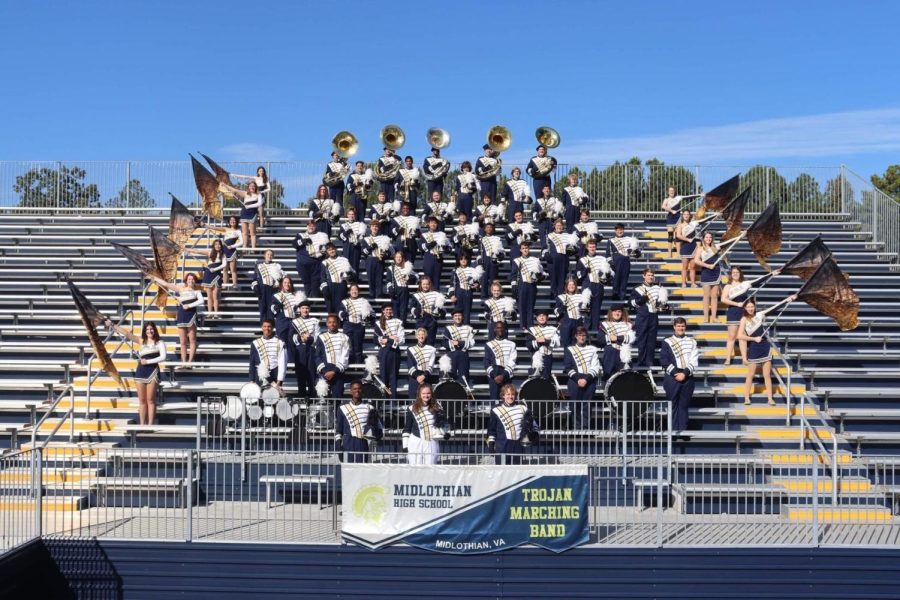Behind the scenes of Midlo’s Marching Band
Marching band through the eyes of an outsider.
Photo by: Midlothian High School Marching Band Facebook
Midlothian High School’s Marching Band 2022.
Everyday after school, as I run my cross country warm-up, I pass by the marching band, always neatly aligned in rows across the field, shiny instruments in-hand. They always seem on beat and professionally in-sync. As someone who only ever played violin in elementary school, but was so off-tune I was told to stop playing in the holiday concert, I am the worst person for musical advice. I couldn’t tell you how to read a sheet of music, nor could I tell the difference between a violin and a viola.
To me, an untrained eye, it seems like marching band just “marches in place” and “plays music” something that I believed, anyone could do. Little did I know just how wrong I was. The more I saw the marching band practice, day after day for hours on end, I became invested.
Okay, so, there’s a line of people in the front playing big xylophones, and okay, there’s people swinging flags.
I had no idea what I was watching, but I was intrigued to learn more. Senior Lilly Smith offered me insight into her world of marching band.
“This is my first year in marching band,” Smith said. “But I’ve done percussion with the school for 4 years. I play the marimba.”
What is percussion? Like drums?
“No,” Smith said. “I always say I do percussion and people will always say ‘Oh, so you’re drumline?’ and I’m like ‘No’. Percussion is any instrument that has to be struck to make a sound, so yes, like drums, but also mallet percussion, which is like xylophones, mallet keyboards, and vibraphones.”
“Marimbas are my pride and joy,” Smith said. “They’re a lot bigger and have a wider range. It has 4 octaves of range and the pitch is lower than a xylophone.”
Okay, so it’s called a marimba, not a big xylophone.
“People always think that it’s easy, and it’s something that anyone can do,” Smith explains. “But it’s such a big time commitment, and if you want to be a part of it, you have to be there everyday.”
Well, how many hours would you say you spend with marching band a week?
“I have 12 hours of rehearsals every week and competitions every other weekend, which take six hours. We also participate in the football games which take all night. I also have to practice when I get home for at least an hour a night.”
Wow.
I wanted to get another input, so I asked senior, Taj Davis, a drum major that conducts the marching band.
“I play the trumpet,” Davis said. I started it because I had one at home, and it was an instrument that was very popular and everyone liked it. I realized that it can be very competitive and it made me want to improve.”
Just like Smith said, Davis explained that “the biggest misconception is that it isn’t a lot of work.”
“Since I am a field commander, I spend eight hours at rehearsals and 12 hours at competitions,” Davis said. “Six hours are spent at a game and six hours at a competition. We have to load the trucks, unload the trucks, and then we warm up.”
So, can anyone do marching band?
“Well, you don’t really have to be athletic. Since it’s not technically a sport, we can have people of all capabilities,” Davis said. “Through marching band, you get a sense of tune, and how to balance with other instruments. It’s a great way to meet new people with similar interests.”
What is the most challenging part of Marching band?
“People always ask how hard it is to keep a beat,” Davis said. “And, it’s really hard.”
“Kate Tabor, our drum major, follows the drumline’s tempo and makes sure the band can follow the tempo. There are a lot of echoes, a lot of stipulations, and you’re supposed to listen closely to the drumline,” Davis said.
In a way, it’s like a secret code. Right?
“Technically yes,” Davis said. “The drumline makes a tempo and we are supposed to listen for it. Standing in the back it can be hard because people will stand in front of you and you cant see, so it’s a lot of listening.”
Six days a week and two hours a day, I bet your team has quite the bond.
“Definitely,” Smith said. “As a marching band as a whole, everyone knows each other, and everyone supports each other, but your section is like your family. I just love it, and it’s my life. It has been for the past four years and I don’t know what else I would do.”
“Its a time when all band kids come together.” Davis said.
In the end, I learned that marching band is more than just “marching in place.” It’s countless hours of practice after school and on the weekends that requires complete dedication. Marching band players have truly perfected the art of staggering the fields in ornate lines while simultaneously playing a variety of instruments from drums, cymbals, and trombones, to trumpets, flutes, and even the marimba (the big xylophone).
After talking with Taj and Lilly, it’s become clear to me that Marching band isn’t for the faintest of hearts, and that I was wrong to believe that “anyone can do it”. It takes a certain mindset to focus, note after note, while playing alongside stands full of screaming students.
In a way, it’s a sport, yet also an art. So, now whenever I run past the band members, I’ll have an added appreciation for the hard work and dedication they put in day after day, representing our school. Thank you marching band, for making our school shine.

Kyle Reeder, Class of 2023
Kyle Reeder has been on staff for four years and is the Multi-Media Editor. Outside of school, he runs cross country and...







